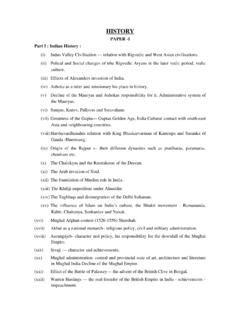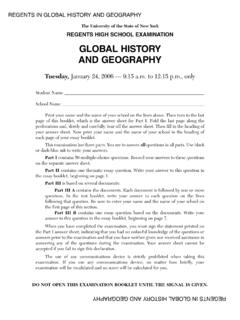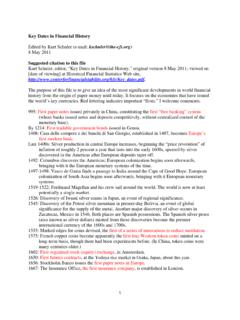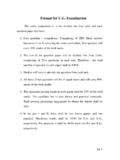Transcription of A Short History of International Currencies By …
1 A Short History of International Currencies By Christopher Weber Money From Long Ago: How it Can Lose Its Value and How it Can Soar Here I am back in Monaco and it s dreary and freezing outside. It was just a few days ago, but the sun of Palm Beach and Costa Rica----[Thanks Adens, for your wonderful hospitality]---seems like so long ago. It makes you realize that the sun is always shining somewhere. And this is not just meant literally either. I've noticed that investment-wise "the sun is always shining somewhere" as well. There is always a bull market in something, even if it just means staying in cash. If everything else is falling, it means your cash is worth more today than it was worth yesterday.
2 Broadening out this concept further, since I was in high school I have been fascinated by the rises and falls of civilizations, especially as symbolized by money. It not only interests me to see great powers ---and their monies--- rise and fall. I am also interested in learning how other places stepped into the vacuum as the great civilizations decay. It used to be thought, in the West at least, that with the fall of the Roman Empire the world was plunged into the Dark Ages. But we now know that other parts of the world saw golden eras at this same time. This was again forcefully brought home to me as I stood amidst the Mayan city of Copan, now close to the Honduran/Guatemalan border.
3 This intriguing civilization had a mixture of advanced science and seemingly barbaric practices----the calendars they came up with are extremely accurate, but after ball games either the winners or the losers had their heads chopped off (we don't know which--it could have been the winners as it was regarded an honor to sacrifice yourself to the gods). But what interested me most was the fact that the Mayan civilization reached its Golden Age, or Classic Age, from about 250 AD to 800 AD. This was precisely the time when Western Europe and its money fell into chaos. It is not clear what the Mayans used for money: apparently gold and silver meant nothing to them (though jade was prized) and it might have been a sophisticated barter economy.
4 But most other civilizations have always used some form of money. And I have found that if you "follow the money" you are able to follow History and learn from it. 1 History has taught me much. For instance, it is amazing to me how fast the currency of the globe's greatest power at any one time can utterly lose its value, bringing chaos as well as opportunity in its wake. I think we are in one of those periods today. The very idea of the US dollar losing its role as the world's reserve currency was laughable even three years ago. Now it is being seriously discussed. How likely is this? What are the signposts up ahead that can tell us the direction things will take? If you are on a road trip and reading signs, it helps to know where you have come from.
5 It s just the same when the journey involves money. That's why I thought it would be valuable to look at the story of money and mankind. I love this subject, but I know that History is not everyone's cup of tea. So I will try to make it as painless as possible. But while not everyone loves History , most people love money. Maybe you are one of them. If so, then this is your lucky day! After all, when you love something, don't you want to know all about it, starting with where it came from? What is Money? If you were all alone in the world or on an island by yourself, you wouldn't need money. You'd have to make due with what you could catch or grow for yourself. If there were others around, you could do what the Mayans did: barter.
6 You could be a fisherman and trade some fish for shoes from a shoemaker. But what if that shoemaker hated fish and was a vegan? You'd have to find a grower of vegetables who wanted your fish and then trade those for the shoes. Barter is simple, but it is not very efficient. It s far better to have something that everyone wants, something that all people can trade with. But what would that something be? Anthropologists, archeologists and historians have discovered that for most every group of people that have ever existed, what was chosen as money had at least five properties to it. 1. It had accepted value to everyone. That's obvious. But what is less obvious is that in all societies, what emerged as money was some commodity that was valued by people for itself first, before it became money.
7 2. It was durable. What's the use of money if it falls apart in a Short time? It had to hold its value as long as possible. That's why lettuce has never been money, though in America during the 1930s, this word was used as slang for money since dollars were green, thin and "leafy". 3. It was easily divisible. It could be broken down into small pieces or amounts for small purchases. 4. Even when it was broken down into small pieces, however, it still had to be consistent in value and quality. One unit of it, gram, ounce or whatever, had to be the exact same as any other unit of the same weight or appearance. Otherwise, there would be chaos. 5. Finally, money had to be convenient to use.
8 That's obvious, too. 2 Gold and Silver Hundreds of commodities have been used as money, from seashells to paper. But time and time again, in civilizations far and wide, two things stand out: You rarely find a time or place where either gold or silver, or both, were not regarded as best having what it took to be money. In this way, the Mayans were the exception that proves the rule. Take the above five attributes of money and both of these metals fit the bill. The paper we now use as money only developed as a convenient substitute for having to carry around lots of gold or silver. When they were first issued, it was clearly written on them that they entitled the bearer to be paid metals on demand.
9 Paper money used in this way can indeed be valuable, but only as long as people have confidence in it, or in the ones who print it. On the other hand, no one today has confidence that the Byzantine Empire has any power at all, yet the gold coins minted by it so long ago still have real and increasing value. Archeologists are almost monthly increasing our knowledge of past civilizations, but as of now it appears that the Greeks, about 800 years before Christ, developed the first money that has truly lasted. To be sure, the Babylonians came up with the idea of stamping bars of gold and silver with their weights and fineness, but as far as we know these were just the markings of the particular metals dealer or trader.
10 Outside of the immediate community, these markings could not be trusted and certainly no government stood behind them. A History of International Currencies We owe the Greeks much. They have been called the clearest thinking of all people in History , and where money is concerned it is hard to argue with this. All of a sudden, they started minting coins that quickly became the first " International currency". Not only did they meet all the five attributes of money, but the money they made was often stunningly beautiful. Many coin experts concur that the most beautiful coin ever made was minted by Greeks in Syracuse (modern Sicily) in about 350 BC. The front, or obverse, is the head of Persephone surrounded by dolphins, and the reverse is a charioteer with Nike --Winged Victory--- crowning his win.


![History of China and Japan 184-1949 [Rai Foundation]](/cache/preview/a/3/3/5/6/9/1/4/thumb-a335691420aa300e037ceb6914287831.jpg)





